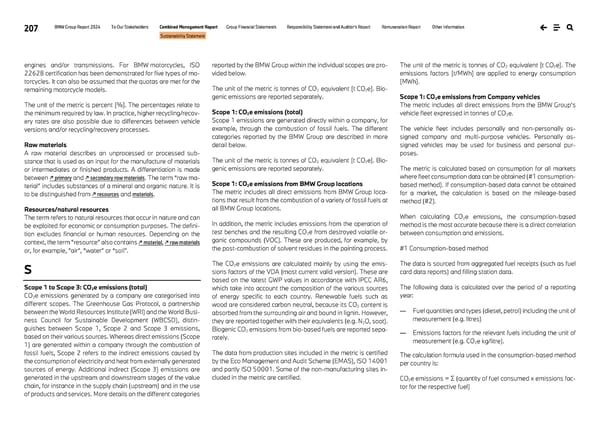207 BMW Group Report 2024 To Our Stakeholders Combined Management Report Group Financial Statements Responsibility Statement and Auditor’s Report Remuneration Report Other Information Sustainability Statement engines and/or transmissions. For BMW motorcycles, ISO 22628 certification has been demonstrated for five types of mo- torcycles. It can also be assumed that the quotas are met for the remaining motorcycle models. The unit of the metric is percent [%]. The percentages relate to the minimum required by law. In practice, higher recycling/recov- ery rates are also possible due to differences between vehicle versions and/or recycling/recovery processes. Raw materials A raw material describes an unprocessed or processed sub- stance that is used as an input for the manufacture of materials or intermediates or finished products. A differentiation is made between ↗ primary and ↗ secondary raw materials. The term “raw ma- terial” includes substances of a mineral and organic nature. It is to be distinguished from ↗ resources and materials. Resources/natural resources The term refers to natural resources that occur in nature and can be exploited for economic or consumption purposes. The defini- tion excludes financial or human resources. Depending on the context, the term “resource” also contains ↗ material, ↗ raw materials or, for example, “air”, “water” or “soil”. S Scope 1 to Scope 3: CO2e emissions (total) CO2e emissions generated by a company are categorised into different scopes. The Greenhouse Gas Protocol, a partnership between the World Resources Institute (WRI) and the World Busi- ness Council for Sustainable Development (WBCSD), distin- guishes between Scope 1, Scope 2 and Scope 3 emissions, based on their various sources. Whereas direct emissions (Scope 1) are generated within a company through the combustion of fossil fuels, Scope 2 refers to the indirect emissions caused by the consumption of electricity and heat from externally generated sources of energy. Additional indirect (Scope 3) emissions are generated in the upstream and downstream stages of the value chain, for instance in the supply chain (upstream) and in the use of products and services. More details on the different categories reported by the BMW Group within the individual scopes are pro- vided below. The unit of the metric is tonnes of CO2 equivalent [t CO2e]. Bio- genic emissions are reported separately. Scope 1: CO2e emissions (total) Scope 1 emissions are generated directly within a company, for example, through the combustion of fossil fuels. The different categories reported by the BMW Group are described in more detail below. The unit of the metric is tonnes of CO2 equivalent [t CO2e]. Bio- genic emissions are reported separately. Scope 1: CO2e emissions from BMW Group locations The metric includes all direct emissions from BMW Group loca- tions that result from the combustion of a variety of fossil fuels at all BMW Group locations. In addition, the metric includes emissions from the operation of test benches and the resulting CO2e from destroyed volatile or- ganic compounds (VOC). These are produced, for example, by the post-combustion of solvent residues in the painting process. The CO2e emissions are calculated mainly by using the emis- sions factors of the VDA (most current valid version). These are based on the latest GWP values in accordance with IPCC AR6, which take into account the composition of the various sources of energy specific to each country. Renewable fuels such as wood are considered carbon neutral, because its CO2 content is absorbed from the surrounding air and bound in lignin. However, they are reported together with their equivalents (e.g. N2O, soot). Biogenic CO2 emissions from bio-based fuels are reported sepa- rately. The data from production sites included in the metric is certified by the Eco Management and Audit Scheme (EMAS), ISO 14001 and partly ISO 50001. Some of the non-manufacturing sites in- cluded in the metric are certified. The unit of the metric is tonnes of CO2 equivalent [t CO2e]. The emissions factors [t/MWh] are applied to energy consumption [MWh]. Scope 1: CO2e emissions from Company vehicles The metric includes all direct emissions from the BMW Group’s vehicle fleet expressed in tonnes of CO2e. The vehicle fleet includes personally and non-personally as- signed company and multi-purpose vehicles. Personally as- signed vehicles may be used for business and personal pur- poses. The metric is calculated based on consumption for all markets where fleet consumption data can be obtained (#1 consumption- based method). If consumption-based data cannot be obtained for a market, the calculation is based on the mileage-based method (#2). When calculating CO2e emissions, the consumption-based method is the most accurate because there is a direct correlation between consumption and emissions. #1 Consumption-based method The data is sourced from aggregated fuel receipts (such as fuel card data reports) and filling station data. The following data is calculated over the period of a reporting year: — Fuel quantities and types (diesel, petrol) including the unit of measurement (e.g. litres) — Emissions factors for the relevant fuels including the unit of measurement (e.g. CO2e kg/litre). The calculation formula used in the consumption-based method per country is: CO2e emissions = Σ (quantity of fuel consumed x emissions fac- tor for the respective fuel)
 BMW Group Report 2024 Page 206 Page 208
BMW Group Report 2024 Page 206 Page 208